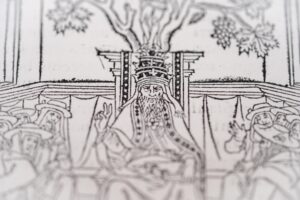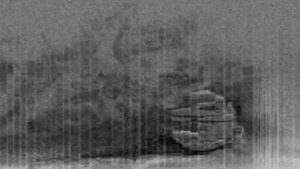It is the place “between the spaces” — a purgatory. At least, the locals on the island of Pohnpei in Micronesia seem to think so. For centuries, restless spirits of dead Pohnpeians have lingered here and vowed to harm any disrespectful visitors. The lost city of Nan Madol is half-submerged and half-taken over by the twisting spines of mangroves.
But first impressions can be deceiving. It is one of the very few places in the world which continues to perplex archaeologists. How and why it was built, and by whom?
Sophisticated construction
Nan Madol is an ancient city in a lagoon dotted with small artificial islands linked by canals. Basalt columns form the base of these constructions; some may be simply fallen pillars.
The origins of Nan Madol have one foot in fiction and the other in history. The locals of Pohnpei Island simply accept the stories of their ancestors as fact. Their culture dates to the 1200s, but human activity goes back even further, to at least 500 CE.
The islanders most likely came from a New Caledonian group called the Lapita. Originally from the Philippines, the Lapita traveled to Micronesia and mixed with local populations. Among the evidence, patterns on pottery shards here match those of the Lapita. Near Nan Madol is a rock art gallery with carvings that are almost identical to those in New Caledonia, 3,000km away. Yet the Lapita were not known for their advanced technology or sophisticated building techniques.

Nan Madol basalt columns. Photo: KKKvintage/Shutterstock
Venice of the Pacific
Nan Madol is often referred to as the Venice of the Pacific because of its canals. The site is 1.5 kilometers by .5 kilometers and encompasses a sea wall, 92 islets, canals, an irrigation system, ceremonial and residential sections, tombs, and even a prison. The entire city complex sits upon a coral reef, and the islets upon which the basalt structures lie are man-made. The boulders and logs are naturally hexagonal and made of volcanic basalt. In total, the complex weighs over 750,000 tons. The walls are 7.5 meters high, and the logs are 5.5 meters long. According to UNESCO, its construction involved
…small island populations in the mining, moving, and maneuvering of an estimated 2,000 tons of volcanic rock every year for at least three to four centuries without the benefit of pulleys, levels, metal tools, or wheels.
Archaeologists and historians find this site hard to believe. How could these simple islanders build such a city, let alone stack megaton logs of basalt on top of each other 7.5 meters high? Micronesian societies were not this advanced. This suggests that its builders were not from around here…
An impressed visitor
In 1836, a British vessel called the Lambton sailed to Micronesia. On board was a curious surgeon named Dr. Campbell, who had been thoroughly impressed by the region’s incredible beauty. As they sailed, they came across a unique structure not seen on the other islands. From a place he had come to know as simple, with modest boats, crafts and tools, the presence of a stone complex that took over an entire reef astounded him. When he asked the native population about it, the language barrier left him incredibly frustrated. He concluded that it was
…the work of a race of men far surpassing the present generation, over whose memory many ages have rolled, and whose history oblivion has shaded forever, whose greatness and whose power can only now be traced from the scattered remains of the structures they have reared, which now wave with evergreens over the ashes of their departed glory, leaving to posterity the pleasure of speculation and conjecture.
As word spread of Nan Madol, other travelers came to see it for themselves. In 1873, Polish naturalist John Stanislaw Kubary visited Nan Madol while traveling through the Marshall and Caroline Islands. He acquired 23 crates worth of materials for museums before losing them in a shipwreck.
In the 1970s and 1980s, archaeologists conducted underwater surveys and found basalt pillars on the seafloor, which meant the complex went deeper than originally thought.
But who built it? It turns out Nan Madol has an odd past, which started with an unexpected arrival on this idyllic island. Let us take a look at Pohnpeian oral tradition.
Unexpected invaders
Locals tell a story of foreigners who came to Pohnpei. It goes like this.
Once upon a time, two charismatic brothers from a distant land came to the native Pohnpeian people and claimed to be sorcerers. Olisihpa and Olosohpa were described as strong giants who were divine intermediaries, controlling both the earthly and spiritual realms. They were said to harness supernatural powers. Some claimed they could control the weather or even communicate with the gods.

An artist’s rendering of the brothers. Photo: mrpsmythopedia
Though the locals did not know where they came from, they welcomed these wise men with open arms. A group of foreign men and women in large canoes accompanied Olisihpa and Olosohpa, wanting to establish a settlement. Oral tradition states they had the power to make the basalt columns float and stack on top of each other.
However, the goodwill did not last long. The brothers quickly secured an iron grip on the humble society, forcing the citizens to pay tribute, do hard labor, and bring them food and water. No one moved without them knowing. No one breathed without them allowing it. They even promoted cannibalism. This carried on for centuries. The brothers founded the island’s Saudeleur dynasty, which reigned until 1628.
Eventual rebellion
From 1200 to 1700, Nan Madol was a cultural and spiritual hub, thanks to the Saudeleurs. At the same time, their grip on power grew tyrannical, and the disillusioned people of Pohnpei eventually rebelled against their rulers’ heavy-handedness. Many Pohnpeians died and were buried within the walls.
The story gets more complicated. Oral tradition says that the Saudeleurs worshipped the god of thunder, Nahnsapwe. They made the locals sacrifice their most sacred animal, the turtle, to a moray eel, which represented him. Nahnsapwe saw all this chaos and decided to intervene. He and a female relative had a demigod son named Isokelekel, who defeated the tyrants in the 1500s. By now, this was not an ancient story but rather a semi-modern one.
Isokelekel brought peace to Pohnpei and established a system of chiefdoms instead of absolute rule. This system is used today on the island.
Eventually, Isokelekel died, and he was buried on a nearby island called Pehi en Kitel. Supposedly, to disturb his remains is to risk dying suddenly and terribly. Nan Madol was slowly abandoned and left to the infringing waves.
While this provides some background, and oral tradition is a valuable tool for historians, it does not paint a complete picture.
What’s real?
First, the Sadeleurs and the subsequent kings might have been real. In 1907, the bones of Isokelekel were supposedly discovered by the island’s German governor, Victor Berg. The bones were much larger than the average human’s. In 1928, the Japanese excavated his tomb and found more giant remains. The bones supposedly are still there, guarded and venerated by the local people. Victor Berg died soon after discovering the tomb.
As for the construction of Nan Madol, scientists have a hypothesis other than magic and floating rocks. On the island, there is a near-vertical hill of basalt. According to writer William S. Aryes of Archaeology magazine,
Initially, local inhabitants transported massive basalt boulders to the reef, forming foundations upon which wood and thatch structures were erected. They then stacked finely fitted basalt columns horizontally around the crude boulder foundations to buttress coral rubble used to level the islet surfaces. Islanders tell us that the columns were quarried by heating large clusters of naturally formed basalt columns with fire and then breaking them apart along natural fissure lines with cold water…
…probably transported by raft at high tide; maneuvering even a small craft at low tide would have been impossible.
There is no evidence that the islanders possessed the technology to carry such great weights. It is most likely that the kings forced the conquered to build it. But how? Some have suggested ropes, but stacking the boulders on top of each other is hard to believe. As of now, archaeologists have no idea how this could have been done.
Connection to the lost continent of Mu
As mentioned in a previous article on the lost continent of Lemuria and Mu, another explanation for Nan Madol’s construction has long focused on an ancient race that was advanced in technology and engineering, and which supposedly originated in Mu. Two men were responsible for pushing the Mu theory. First was Augustus Le Plongeon. In his studies of the Yucatan Peninsula and the Maya, he argued that they came from a lost continent, based on his translations of the Popol Vuh and Madrid Codex. In his book, Queen Moo & The Egyptian Sphinx, he said:
In our journey westward across the Atlantic, we shall pass in sight of that spot where once existed the pride and life of the ocean, the Land of Mu, which, at the epoch that we have been considering, had not yet been visited by the wrath of Human, that lord of volcanic fires to whose fury it afterward fell a victim. The description of that land given to Solon by Sonchis, priest at Sais; its destruction by earthquakes, and submergence, recorded by Plato in his Timaeus, have been told and retold so many times that it is useless to encumber these pages with a repetition of it…
Disaster strikes
The people of Mu were purportedly advanced in engineering, writing, and city planning. However, a series of natural disasters, such as earthquakes and volcanic eruptions, caused it to sink beneath the Pacific like Atlantis.
British explorer and mystic James Churchward also supported this theory. Churchward believed that Mu was a vast continent situated in the middle of the Pacific Ocean and stretched from Hawaii to the enigmatic Easter Island. He suggested that Nan Madol was a remnant of Mu, and the people residing there were the survivors.
Needless to say, such explanations have been dismissed as pseudoscience.
Visiting today
Getting there is a challenge even today, but not because of the rugged landscape and thick jungle. It requires extraordinary permission from Pohnpei’s current king in a special ceremony with the local elders and a semi-psychedelic drink that will make you unsteady on your feet for a bit. You have to ask for their approval, promise to be respectful, and receive spiritual protection. More visitors have come as popular National Geographic documentaries and the infamous Ancient Aliens TV series have led curious minds to this far corner of the world.
Conclusion
Strangely, archaeology has largely neglected Nan Madol. Few studies have been done, and many questions remain. We are not sure if it’s due to cultural sensitivity and the heritage of the Pohnpeian people, who believe these stories to be real, or the dismissal of anything pseudoscientific.






